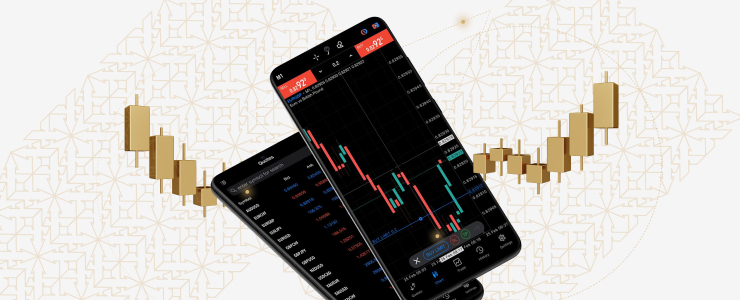A new trader may find themselves concerned when they hear that their preferred asset or sector is bearish. They may look at their trade portfolio and see all red, which could cause panic and poor decisions. However, it doesn’t have to be like that.
Trading has two primary mechanics: buying and selling. More specifically, in CFD trading, this translates to opening buy and sell orders. By executing both and balancing them properly traders have the chance of prospering regardless of the market conditions they encounter. As such, mastering these is a crucial step if you intend to become a complete trader.
However, before we get to explaining these types of trading, we need to remove some terminology misconceptions.

Buying and selling – Traditional vs CFD trading
In traditional trading, buying and selling can mean something completely different. Furthermore, since this is the prevalent form of trading in various media, these meanings have become colloquialised. As such, someone may have an entirely wrong mindset when it comes to buying and selling CFDs.
Buying is largely the same, as both in traditional trading and CFD trading it means purchasing an asset with hopes its price will increase. It’s the first trading action most traders take and should feel familiar very soon.
However, in traditional trading, selling refers to selling an asset you’ve already bought, thus shrinking or terminating your position. This means you must buy first so that you can sell later, which also sounds reasonable to most people. However, it may also lead to the misconception that this is the only way of trading. In CFD trading, this action is called closing, terminating or executing your position
Understanding Buy, Sell, and Close
Calling this action ‘opening a sell order’ may make things slightly clearer, as selling from thin air may confuse some traders. Essentially, what you’re doing is speculating that the asset price will fall and making a contract with your broker that will allow you to profit from that. It’s analogous to shorting or short selling in traditional trading.
So, what you need to remember for CFD trading is:
- Buying (opening a buy order) – Opening a position where you’ll profit if your asset increases in value
- Selling (opening a sell order) – Opening a position where you’ll profit if your asset decreases in value
- Closing, executing, or terminating a position – Exiting a previously opened position and collecting any profits or losses that may occur

Buying
Now that we’re clear on our terms, let’s start with the topic at hand. Buying, as we said, involves opening a position when you believe market conditions will lead to an increase in value. It’s usually very easy to find how to do so in online trading platforms and only involves pressing a few buttons.
Buying is the default for most traders. It’s easier to make good trading conditions when markets are healthy and growing. As such, buy orders comprise the bulk of most CFD traders’ portfolios.
In some ways, that makes a lot of sense. The assumption is that the economy constantly keeps expanding and markets keep growing. In other words, that means that the average asset will increase in value over time. For traders looking at the long term, this means that the more sensible option is to buy.
Additionally, assets like precious metals and indices are often called safe instruments. They either grow regardless of what’s happening in the overall market or cover market segments so crucial to certain economies that they are highly unlikely to fail. Again, this imposes buying as the preferred option.
Lastly, even in prolonged bear markets, if you have trust that your asset will recover, buying can be a good option. In fact, that’s usually where the highest profit potential is.
All this may sound like buying is clearly the superior option, but most of these advantages are slight or only noticeable in the longer term. And we won’t discount that, but most active traders will also want to profit in more immediate time frames. And to do that, as well as become able to thrive in varied market conditions, you’ll need to master selling as well.
Selling in CFD trading
Selling is the inherently riskier form of trading. To explain, we’ll use a simple example: say you see an asset that’s worth £100. If you open a buy position, the most you can lose is £100, if the asset drops down all the way to 0. However, if you sell and the instrument jumps to £1,000, your loss is £900. In theory, the potential loss is infinite, since there’s no hard limit on how much the value could increase.
We’re not saying this to scare you, of course. In fact, such significant jumps are so rare that even many lifetime traders never see them. However, we will note that, once you start selling, you need to stay on top of your risk management. We’ll go over some of the basic methods you can use for that soon.
Selling in CFD trading applies to a wide variety of cases. However, perhaps the two most common ones to make use of are reports and panic.
Reports, whether they be company financial performance announcements or government policy, can often make markets shift significantly. Traders tend to overreact, and even slightly bad news can trigger significant panic. Traders who correctly predict that a report may not indicate good performance can potentially draw a lot from the ensuing market reaction.
Other things can cause panic too. Markets reaching certain negative thresholds, bad economic news, poor behaviour from company higher-ups, the list goes on. Catching these early and capitalising on them can lead to significant short-term gains, especially with a solid entry and exit plan.
Another significant thing for people who want to master selling is to spot times of general economic downturn. These are often relatively short, but markets tend to move in packs. If, for instance, you notice that the US tech sector is down, that may mean that the rest is soon to follow, at least temporarily. In such conditions, traders who establish sell orders may breeze through the inconvenience while everyone else may struggle.

Stop losses and take profits
As we mentioned, it’s also important to master some basic risk management strategies along with buying and selling. Stop losses and take profits are the easiest, since they are very intuitive and in most platforms, you set them while placing your order.
Their names make their functions quite intuitive. Take profits close your position once you reach a certain profit threshold, and stop losses close it once the trade loses enough. One thing of note is that they’ll work the opposite way when buying and selling.
When you buy, you can place a take profit point at a price above the current one, and a stop loss below. When you sell, your take profit will be below the current price and your stop loss above. Again, we emphasise the importance of stop losses when selling, due to the (although remote) chance of extreme price jumps.
That’s the rundown of buying and selling in CFD trading. They are fairly simple concepts, but mastering them gives you the skills to prosper whatever the markets throw at you. Of course, placing your trades wisely is another matter, and you can learn more on how to do that right here, in Xlence’s educational blog!
Disclaimer:This information is not considered investment advice or an investment recommendation, but instead a marketing communication.




